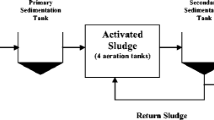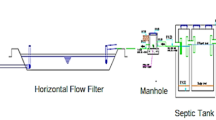Abstract
A comprehensive understanding of wastewater characteristics is vital in the design and operation of collection, treatment, and disposal facilities and the engineering management of environmental quality. Municipal wastewater generated from the Federal University of Technology, Akure and discharged untreated was determined for feasible irrigation reuse. In this study, physicochemical (odour, temperature, turbidity, total dissolved solids, suspended solids, total hardness, pH, alkalinity, chlorides, nitrates, and phosphates) and bacteriological parameters (total bacterial count and total coliform) of wastewater were examined. The maximum value (1408 mg/L) of the total dissolved solids was found in the sample collected from Akindeko hall in the evening and the pH values ranges between 7.09 and 8.41. Maximum nitrate is 58.2 mg/L in the sample collected from Abiola hostel, phosphate is 43.4 mg/L in Akindeko hostel, and chloride is 243.2 mg/L in Abiola hostel. The total bacterial count and total coliform count range from 93.67 to 148.33 mg/L and 115.33 to 136 mg/L. The findings of the study conclude that the wastewater quality of the university’s halls of residence was above the standard value of the United States Environmental Protection Agency guidelines for irrigation reuse when compared. This implies that its usage for irrigation without treatment should be prohibited, since it adversely affects the soil’s properties and releases hazardous substances to the environment. It is, therefore, recommended that a sustainable treatment system be provided to adequately treat all wastewater generated from the university and prevent extra expenses for soil treatment while reutilize for irrigation to supplement natural rainfall for agricultural purposes.


Similar content being viewed by others
References
Adewumi, J. R., & Ajibade, F. O. (2015). The pollution effects of indiscriminate disposal of wastewater on soil in semi-urban area. Journal of Applied Science and Environmental Management,19(3), 412–419.
Adewumi, J. R., Ilemobade, A. A., & van Zyl, J. E. (2010). Treated wastewater effluent reuse in South Africa: Overview, potential and challenges. Resources, Conservation and Recycling,55(2), 221–331.
Ajibade, F. O. (2013). Design of a central wastewater disposal system for an urban area Using FUTA campus as case study. Unpublished M. Eng. Thesis, Department of Civil and Environmental Engineering, Federal University of Technology, Akure (pp 40–43).
Ajibade, F. O., & Adewumi, J. R. (2017). Performance evaluation of aquatic macrophytes in a constructed wetland for municipal wastewater treatment. FUTA Journal of Engineering and Engineering Technology,11(1), 1–11.
Ajibade, F. O., Adewumi, J. R., & Oguntuase, A. M. (2014a). Sustainable approach to wastewater management in the Federal University of Technology, Akure, Nigeria. Nigerian Journal of Technological Research,9(2), 27–36.
Ajibade, F. O., Adewumi, J. R., & Oguntuase, A. M. (2014b). Design of improved stormwater management system for the Federal University of Technology Akure. Nigerian Journal of Technology (NIJOTECH),33(4), 470–481.
Akinbile, C. O., Ajibade, F. O., & Ofuafo, O. (2016a). Soil quality analysis for dumpsite environment in a University Community in Nigeria. FUTA Journal of Engineering and Engineering Technology,10(2), 68–73.
Akinbile, C. O., Erazua, A. E., Babalola, T. E., & Ajibade, F. O. (2016b). Environmental implications of animal wastes pollution on agricultural soil and water quality. Soil Water Research,11(3), 172–180. https://doi.org/10.17221/29/2015-SWR.
Akinbile, C. O., Famuyiwa, O. A., Ajibade, F. O., & Babalola, T. E. (2016c). Impacts of varying tillage operations on infiltration capacity of agricultural soils. International Journal of Soil Science,11(2), 29–35. https://doi.org/10.3923/ijss.2016.
Alghobar, M. A., & Suresha, S. (2017). Evaluation of metal accumulation in soil and tomatoes irrigated with sewage water from Mysore city, Karnataka, India. Journal of the Saudi Society of Agricultural Sciences,16(1), 49–59.
Association, American Public Health. (2012). Standard method for the examination of water and wastewater (22nd ed.). Washington, DC: American Water Work Association and Water Environment Federation.
Balkhair, K. S., & Ashraf, M. A. (2016). Field accumulation risks of heavy metals in soil and vegetable crop irrigated with sewage water in western region of Saudi Arabia. Saudi Journal of Biological Sciences,23(1), S32–S44.
Braga, J. K., & Varesche, M. B. A. (2014). Commercial laundry water characterization. American Journal of Analytical Chemistry,5(01), 8–16.
Chaoua, S., Boussaa, S., El Gharmali, A., & Boumezzough, A. (2018). Impact of irrigation with wastewater on accumulation of heavy metals in soil and crops in the region of Marrakech in Morocco. Journal of the Saudi Society of Agricultural Sciences. https://doi.org/10.1016/j.jssas.2018.02.003.
Chys, M., Demeestere, K., Nopens, I., Audenaert, W. T., & Van Hulle, S. W. (2018). Municipal wastewater effluent characterization and variability analysis in view of an ozone dose control strategy during tertiary treatment: The status in Belgium. Science of the Total Environment,625, 1198–1207.
El Moussaoui, T., Wahbi, S., Mandi, L., Masi, S., & Ouazzani, N. (2019). Reuse study of sustainable wastewater in agroforestry domain of Marrakesh city. Journal of the Saudi Society of Agricultural Sciences, 18(3), 288–293.
Eriksson, E., & Donner, E. (2009). Metals in greywater: Sources, presence and removal efficiencies. Desalination,248(1–3), 271–278. https://doi.org/10.1016/j.desal.2008.05.065.
Frascari, D., Zanaroli, G., Motaleb, M. A., Annen, G., Belguith, K., Borin, S., et al. (2018). Integrated technological and management solutions for wastewater treatment and efficient agricultural reuse in Egypt, Morocco, and Tunisia. Integrated Environmental Assessment and Management,14(4), 447–462.
Friedler, E. (2004). Quality of individual domestic greywater streams and its implication for onsite treatment and reuse possibilities. Environmental Technology,25(9), 997–1008. https://doi.org/10.1080/09593330.2004.9619393.
Gatta, G., Gagliardi, A., Disciglio, G., Lonigro, A., Francavilla, M., Tarantino, E., et al. (2018). Irrigation with treated municipal wastewater on artichoke crop: assessment of soil and yield heavy metal content and human risk. Water,10(3), 255. https://doi.org/10.3390/w10030255.
Ilori, B. A., Adewumi, J. R., Lasisi, K. H., & Ajibade, F. O. (2019). Qualitative assessment of some available water resources in Efon-Alaaye, Nigeria. Journal of Applied Science and Environmental Management,23(1), 29–34. https://doi.org/10.4314/jasem.v23i1.5.
Khan, Z. M., Kanwar, R. M. A., Farid, H. U., Sultan, M., Arsalan, M., Ahmad, M., et al. (2019). Wastewater evaluation for Multan, Pakistan: Characterization and agricultural reuse. Polish Journal of Environmental Studies,28(4), 2159–2174.
Libutti, A., Gatta, G., Gagliardi, A., Vergine, P., Pollice, A., Beneduce, L., et al. (2018). Agro-industrial wastewater reuse for irrigation of a vegetable crop succession under Mediterranean conditions. Agricultural Water Management,196, 1–14.
Mahmood, A., & Malik, R. N. (2014). Human health risk assessment of heavy metals via consumption of contaminated vegetables collected from different irrigation sources in Lahore, Pakistan. Arabian Journal of Chemistry,7(1), 91–99.
Muhirwa, D., Nhapi, I., Wali, U. G., Banadda, N., Kashaigili, J., & Kimwaga, R. (2018). Characterization of wastewater from an abattoir in Rwanda and the impact on downstream water quality. http://repository.costech.or.tz/handle/20.500.11810/3409. Accessed on 15th April, 2019.
Pandey, S. N. (2008). Growth and biochemical changes in pulse seedlings irrigated with effluent from electroplating industry. Journal of Applied Biological Science,34, 79–82.
Pourcher, A., Bonnaud, P., Oise, F., & Virginie, F. (2007). Survival of faecal indicators and enteroviruses in soil after land spreading of municipal sewage sludge. Applied Soil Ecology,35, 473–479.
Shakir, E., Zahraw, Z., & Al-Obaidy, A. H. M. (2017). Environmental and health risks associated with reuse of wastewater for irrigation. Egyptian Journal of Petroleum,26(1), 95–102.
Sharma, S. K., Vijendra, S., & Chandel, C. P. S. (2006). Evaluation of Physicochemical parameters and suitability of industrial waste water and ground water for irrigation. Environmental Ecosystem,24, 915–919.
Sika, A. E., Traoré, V., Samaké, D., Traoré, D., & Kotelevtsev, S. V. (2016). Evaluation of heavy metal pollution in the Niger River Ecosystem in Bamako. European Journal of Scientific Research,137(1), 103–110.
Simpson, B. (2017). Science and ecosystem support division (SESD) operating procedure for wastewater sampling wastewater sampling (SESDPROC-306-R4). Region 4, US Environmental Protection Agency, SESD, Athens, Georgia. https://www.epa.gov/quality/procedures-collecting-wastewater-samples. Accessed on 22nd July, 2019.
Tallon, P., Magagna, B., Lofranco, C., & Leung, K. T. (2005). Microbial indicators of fecal contamination in water: a current perspective. Water, Air, and Soil Pollution,166, 139–166.
USEPA, United State Environmental protection Agency. (2004). Guidelines for Water Reuse. EPA/625/R-04/108.
Villamar, C. A., Vera-Puerto, I., Rivera, D., & De la Hoz, F. (2018). Reuse and recycling of livestock and municipal wastewater in Chilean agriculture: A preliminary assessment. Water,10(6), 817. https://doi.org/10.3390/w10060817.
Zakir, H. M., Shikazono, N., & Otomo, K. (2008). Geochemical distribution of trace metals and assessment of anthropogenic pollution in sediments of Old Nakagawa River, Tokyo, Japan. American Journal of Environmental Science,4, 654–665.
Acknowledgements
The authors acknowledge the management of Federal University of Technology, Akure, Nigeria for their technical support. This research did not receive any specific grant from funding agencies in the public, commercial, or not-for-profit sectors.
Author information
Authors and Affiliations
Corresponding author
Ethics declarations
Conflict of interest
The authors declare no conflicts of interest.
Rights and permissions
About this article
Cite this article
Adewumi, J.R., Ajibade, F.O. Periodic determination of physicochemical and bacteriological characteristics of wastewater effluents for possible reuse as irrigation water. Int J Energ Water Res 3, 269–276 (2019). https://doi.org/10.1007/s42108-019-00036-6
Received:
Accepted:
Published:
Issue Date:
DOI: https://doi.org/10.1007/s42108-019-00036-6




